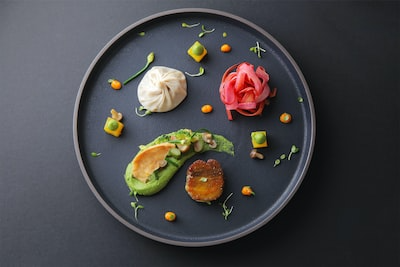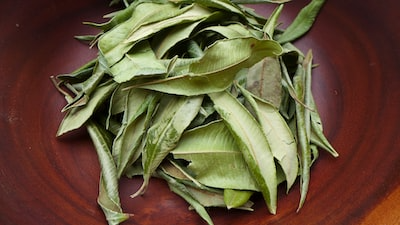
Lemon Myrtle: Australia's Native Aroma and Flavour Secret
You're not alone if you haven't yet heard of Lemon Myrtle. It's a hidden gem in the Australian food and wellbeing world. This native tree is a goldmine for chefs, herbalists, and essential oil enthusiasts alike.
The Lemon Myrtle brings to mind vivid images: leaves with an intense citrus scent that awakens your senses; creamy white flowers blooming against lush greenery; flavours that transform ordinary dishes into gourmet delights.
From enhancing your favourite recipes with its unique citrus flavour to brewing aromatic teas or even extracting essential oils used in wellness products - there are so many ways this versatile plant can be utilised!
Eager to know more?
Table Of Contents:
- Understanding Lemon Myrtle
- Culinary Uses of Lemon Myrtle
- Lemon Myrtle Essential Oil
- Lemon Myrtle in Seasonings and Spices
- Lemon Myrtle Honey and Salad Sprinkles
- Cooking with Lemon Myrtle
- Storing Lemon Myrtle
- FAQs in Relation to Lemon Myrtle
- Conclusion
Understanding Lemon Myrtle
Lemon Myrtle, scientifically known as Backhousia citriodora, is a native Australian plant cherished for its many uses and captivating lemon scent. Indigenous to the wetter coastal areas of northern New South Wales and southern Queensland, this rainforest tree has made its mark in various industries.
Characteristics of Lemon Myrtle
This vibrant green leafy shrub can reach heights up to 3 meters, making it an eye-catching feature tree in any garden setting. But what truly sets the Lemon myrtle leaves apart are their rich citrus notes which are refreshingly intense when crushed or distilled.
The young trees produce creamy white flowers during Autumn that contrast beautifully against the lush green leaves. These aren't just ornamental but play a vital role in attracting pollinators ensuring successful propagation.
Cultivation and Harvesting Process
Australian natives like lemon myrtles thrive best under specific conditions such as soil moisture status and wind protection arrangements within plantation layout designs. They have some frost drought resistance too. To prevent loss due to harsh weather or pests like sooty moulds, growers monitor surface moisture closely while also considering factors like wind gusts.
In terms of harvesting, both mature leaves from older plants and fresh lemon scented ones from younger shoots serve different purposes. The process requires keen observation skills along with knowledge about leaf analyses - understanding oxidant activity helps determine optimal harvest times.
Culinary Uses of Lemon Myrtle
Lemon myrtle, a standout in the Australian native flora, has been making waves in culinary circles with its vibrant citrus flavour and intoxicating lemon scent. The diversity of this plant permits it to be utilised in an array of dishes and drinks.

Enhancing Flavours with Lemon Myrtle
A common feature in spice blends, lemon myrtle leaves lend a unique citrus note that complements various ingredients beautifully. Its refreshingly intense citrus notes can turn any ordinary dish into something extraordinary.
The mature leaves are often cool dried and ground into a fine powder for use as a flavoring agent. It's no surprise then that chefs love adding it to their secret spice mix or using it as part of the cookie mix.
Beyond spices, you'll also find lemon myrtle playing star roles in jams like the Organic Lemon Myrtle Mango Jam. And if you've ever had popcorn with that little extra zing, chances are there was some Lemon Myrtles 50gm powder involved.
Lemon Myrtle in Beverages
Moving on from food, let’s talk about drinks. A cuppa tea is quite an institution down under but imagine giving your daily brew a fresh twist by infusing it with some aromatic lemon-scented myrtles leaf?
In fact, our very own homegrown Native Tea Blenders have curated an amazing blend featuring these green leaves. Check out their Native Tea Blenders kit.
This versatile ingredient not only imparts fantastic flavours but is known for its antioxidant activity too. So, whether it's a hearty stew or a soothing cup of tea, adding some lemon myrtle is sure to lift your culinary experience.
Now that you've got the inside scoop on using lemon myrtle in your kitchen, why not start experimenting? Just remember - as with any herb or spice - less is more. Start small and adjust according to taste. Happy cooking.
adjust as needed. Like with any spice, a little Lemon Myrtle goes a long way. But don't be afraid to experiment. You'll find that its vibrant flavour can really make your dishes pop and bring an authentic Aussie touch to your table.
Lemon Myrtle Essential Oil
Extracted from the green leaves of the Lemon Scented Myrtle tree, this essential oil has a vibrant citrus scent, similar to lemongrass and lime. It's not just about fragrance though; it packs quite a punch in terms of benefits too.
Production of Lemon Myrtle Essential Oil
The process starts with mature leaves from lemon myrtles. These are steam distilled to extract the precious essential oil.
Lemon myrtle essential oil 25ml is one popular option for those looking to try out its unique properties.
Care must be taken when handling these oils, as they can cause skin irritation if applied directly without dilution. But don't let that deter you - their uses far outweigh this minor inconvenience.

Uses of Lemon Myrtle Essential Oil
If fresh lemon scents are your thing, then look no further than Lemon Myrtle Essential Oil. Its intense citrus notes make it an ideal addition for homemade cleaning products or air fresheners.
In aromatherapy circles, it's prized for its calming effect on mind and body alike - perfect for unwinding after a long day.
Beyond aroma-therapeutic applications, this native Australian botanical finds use in various skincare formulations due to its potent antioxidant activity which helps fight off harmful free radicals thereby protecting our skin cells.
Refillable options like this 60gm pack, allow us more eco-friendly ways to keep enjoying all that lemon myrtles have got on offer.
Remember, though it's natural, Lemon Myrtle Essential Oil is still potent. Always use with caution and in advised quantities.
The benefits of lemon myrtle are extensive - whether used as a flavoring agent or for its refreshing aroma.No wonder this Australian native tree has gained popularity across the globe.
Lemon Myrtle Essential Oil, with its zesty scent and myriad benefits, is a true Aussie gem. Extracted from mature leaves of the tree through steam distillation, it's prized in aromatherapy for calming effects and also used in skincare due to potent antioxidant activity. But remember - use wisely.
Lemon Myrtle in Seasonings and Spices
When it comes to enhancing the flavour of your dishes, Lemon Myrtle, a native Australian plant, offers an extraordinary citrus note. Used as a seasoning ingredient, it can truly transform ordinary meals into something special.
Lemon Myrtle as a Seasoning Ingredient
Ever wonder how chefs achieve those intense citrus notes in their dishes? Often, they turn to Lemon Myrtle. With its refreshingly intense citrus flavour, this green leaf is like no other spice blend on the market. And when added to food - be it meats or veggies - the results are nothing short of mouthwatering.
The mature leaves are cool dried before being turned into powder form for use in seasonings and spices. But make sure you store them properly. Keep them in a cool dry place away from surface moisture to prevent loss of that signature lemon scent.
Spicy Lemon Myrtle Sea Parsley Seasoning is one such product where you can taste the robustness of this wonderful plant’s flavoursome profile. For more options on how you could add some zestiness to your kitchen adventures with lemon myrtles seasoning products check out our Australian Bush Spices Collection.
Apart from bringing life-enhancing flavours onto your plate these powerful leaves also carry strong antioxidant activity which adds another reason why they’re loved by many households across Australia.
Lemon Myrtle Honey and Salad Sprinkles
Discover the vibrant world of Lemon Myrtle honey and salad sprinkles.
The Making of Lemon Myrtles Honey
Honey is nature's liquid gold, but when infused with Lemon myrtle leaves, it becomes a flavourful delight. The fresh lemon scent blends perfectly with the sweetness of honey, offering an experience that's hard to resist.
This unique blend owes its charm to Australia’s native rainforest tree - lemon myrtles. Rich in oxidant activity, these trees offer more than just citrus notes for our taste buds. They also serve as a health boost due to their antioxidant properties.
Lemon Myrtles Green Salad Sprinkle
Moving beyond sweet delights, let's talk about green salad sprinkles featuring our star ingredient: lemon myrtle leaf. These versatile sprinkle packs not only enhance flavours but also make your salads look irresistible.
You'll find them adding refreshingly intense citrus notes while elevating the overall dining experience. Plus, they're so easy-to-use; just sprinkle over your greens before serving or mix into your favourite dressing for an extra kick.
Remember mates. When using Australian natives like lemon myrtle in food products or even creating DIY essential oils at home – always remember to store cool dried leaves in a cool dry place after harvesting.
Note:
'You may have noticed some other common names such as 'sweet verbena tree', 'lemon scented ironwood', popping up when talking about this wonderful plant.'
To end off on a fun note:
Fun Fact:
'Did you know? The creamy white flowers from mature trees can be used as beautiful garnishes too.'
So whether you're enjoying a cuppa with lemon myrtle honey or adding an exciting twist to your salads, remember that every bit of it is pure Australian goodness.
For a fresh burst of flavour, don't miss out on our Green Salad Sprinkle. It's sure to make your salads sing.
Take a dive into the rich flavours of Lemon Myrtle honey, our unique blend that combines nature's liquid gold with Australia's native lemon myrtles. This honey not only tastes great but also offers health benefits from its antioxidant properties. Fancy something different? Why not add an exciting twist to your salads with our green salad sprinkles. They feature refreshing citrus notes straight from lemon myrtle leaves. Just remember, after you've enjoyed their zestiness, make sure to store any leftover cool dried leaves in a dry place.
Cooking with Lemon Myrtle
Lemon myrtle, a native Australian plant, is an absolute game changer in the kitchen. It adds that refreshing citrus flavour to your meals, along with some amazing health benefits.
Baking with Lemon Myrtle
Let's talk cookies first. When you use Lemon Myrtle and Wattleseed Cookie Mix, every bite becomes a treat of lemony goodness. But it doesn't stop there; this aromatic herb works wonders in other baked goods as well.
You can experiment by adding powdered lemon myrtle leaves into muffins or cakes for an intense citrus note that'll have everyone asking what your secret ingredient is. Just make sure to keep them cool and dry once baked, which helps preserve their delightful taste and aroma.
If you're looking at breads, imagine the scent of fresh bread mingling with notes of sweet verbena tree – because yes, one of the common names for lemon myrtles happens to be 'sweet verbena'. Now wouldn't that get your morning off on the right foot?

Culinary Uses Beyond Baked Goods
Lemon myrtle isn’t just limited to baking though. With its robust antioxidant activity and distinct flavour profile marked by refreshingly intense citrus notes (not unlike those found in lemongrass), it serves as a versatile flavoring agent across various cuisines too.
A sprinkle over seafood before grilling or roasting imparts an unforgettable zesty tanginess. Even something as simple as popcorn turns gourmet when seasoned lightly using our favourite popcorn 30g sponsor package.
The Perfect Brew
Did you know lemon myrtle can also be a delicious addition to your beverages? You might have spotted it as an ingredient in some tea bags. The fresh, citrusy flavour and calming properties of this native tree make it perfect for brewing into a relaxing cuppa.
See if you can liven up your cooking, take it to the next level or just make yourself a relaxing cuppa – Lemon Myrtle is here for you. Give it a go today.
Embrace the culinary versatility of Lemon Myrtle, an Australian native that amps up your meals with a refreshing citrus zing. It's perfect for baking cookies or breads, adding flavour to seafood and even brewing into a calming cuppa. Don't hold back - experiment today.
Storing Lemon Myrtle
If you're lucky enough to get your hands on some fresh Lemon Myrtle leaves, it's essential to know how to store them properly. Storing these aromatic Australian native gems correctly helps maintain their refreshingly intense citrus notes and potent antioxidant activity.
Start by picking mature leaves from the lemon myrtle tree, preferably those with vibrant green colouration. Young trees are often more fragrant but be mindful not to strip them bare as they need plenty of foliage for photosynthesis.
Lemon myrtles, also known by common names like sweet verbena tree or lemon ironwood, can handle frost and drought, but when it comes down to storing its leaves or powder form - cool dry conditions prevail. The key is preventing moisture build-up that could lead to moulds; sooty moulds being a particular enemy of this rainforest plant.
Cool Dried Leaves Storage
To ensure the longevity of your dried lemon myrtle leaf stash, place them in an air-tight container away from direct sunlight. Store in a cool dry area – think pantry rather than above your oven. This method will help preserve their flavour for up to 18 months.
Fresh Leaf Refrigeration
For fresh leaves straight off the tree, wrap them gently in paper towel before placing inside a sealed plastic bag in your refrigerator crisper drawer – they should stay sprightly for about two weeks this way.
Powdered Lemon Myrtle Preservation
The powdered form is another popular way people use this delightful Aussie botanical due to its convenience and versatility as a spice blend ingredient or cookie mix enhancer. Similar rules apply here – keep your lemon myrtle powder in a tightly sealed container stored in a cool, dry place.
If you're looking to explore the many uses of lemon myrtle from cooking to creating essential oils, start with proper storage. This ensures you get the most out of its citrus flavour and potent antioxidant properties. And remember, it's not just about preserving this amazing plant; it's also about respecting our native Australian flora.
For powdered lemon myrtle, similar rules apply. You need to keep it in a cool, dry place away from sunlight to preserve its potency and flavour. With the right storage methods, you can savour this Aussie favourite for longer.
FAQs in Relation to Lemon Myrtle
What is Lemon Myrtle in Australia?
Lemon Myrtle, or Backhousia citriodora, is a native Australian plant. Known for its citrusy aroma and flavour, it's used widely in cooking and essential oil production.
How did aboriginals use Lemon Myrtle?
The indigenous people of Australia used Lemon Myrtle traditionally for its medicinal properties. It was also part of their diet due to the zesty flavour.
What is Lemon Myrtle good for?
Besides being a popular ingredient in food and beverages, Lemon Myrtle offers health benefits too. Its high citral content makes it an ideal choice for producing essential oils with antimicrobial qualities.
How tall does a Lemon Myrtle grow?
A matured lemon myrtle can reach up to 20 meters when grown in open ground but stays within 2-5 meters if cultivated under controlled conditions like backyards or containers.
Conclusion
So, you've jour So you've journeyed with us through the world of Lemon Myrtle. You’ve learned how this Australian native is grown and harvested, appreciated its citrusy charm in various dishes and drinks.
So you've journeyed with us through the world of Lemon Myrtle. You’ve learned how this Australian native is grown and harvested, appreciated its citrusy charm in various dishes and drinks.
You've discovered how essential oil from this sweet verbena tree can enhance wellness products. Dabbled in using it as a unique ingredient for seasonings or baking those unforgettable cookies.
Bet you never thought that such an ordinary-looking leaf could be so extraordinary! It's not just about its flavour or aroma - it's also about embracing sustainable practices by making use of our own Aussie backyard bounty.
Remember to store your lemon myrtle leaves right: cool dry places are best to retain their fresh lemon scent. That’s a little secret for keeping your pantry smelling heavenly!
No matter where life takes ya next, keep exploring those unexpected guests like the Lemon Myrtle – they might just surprise ya!


